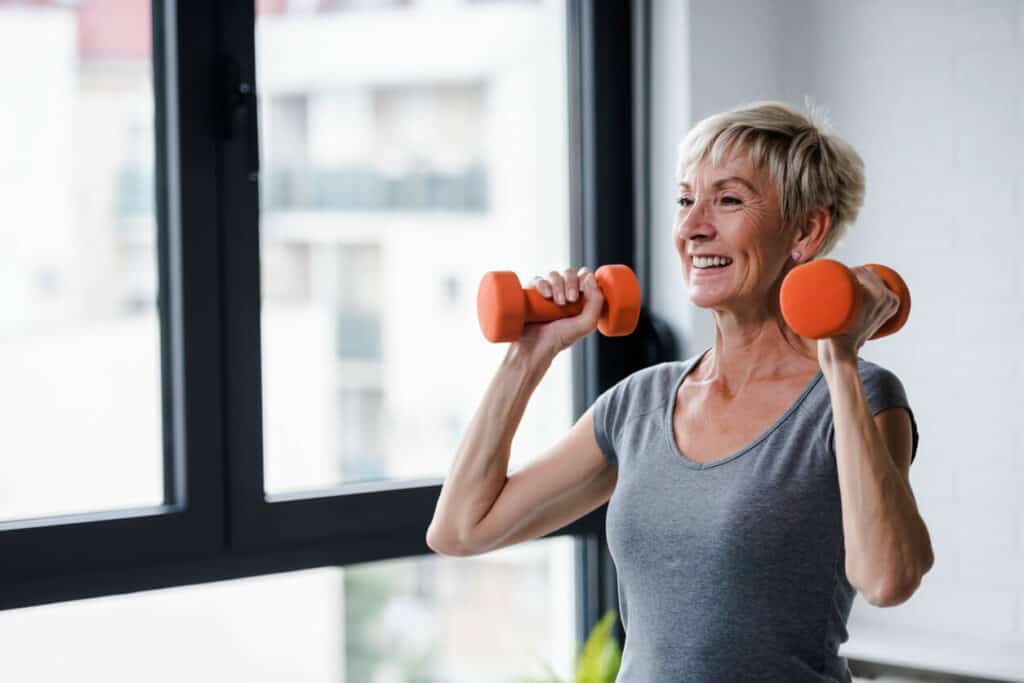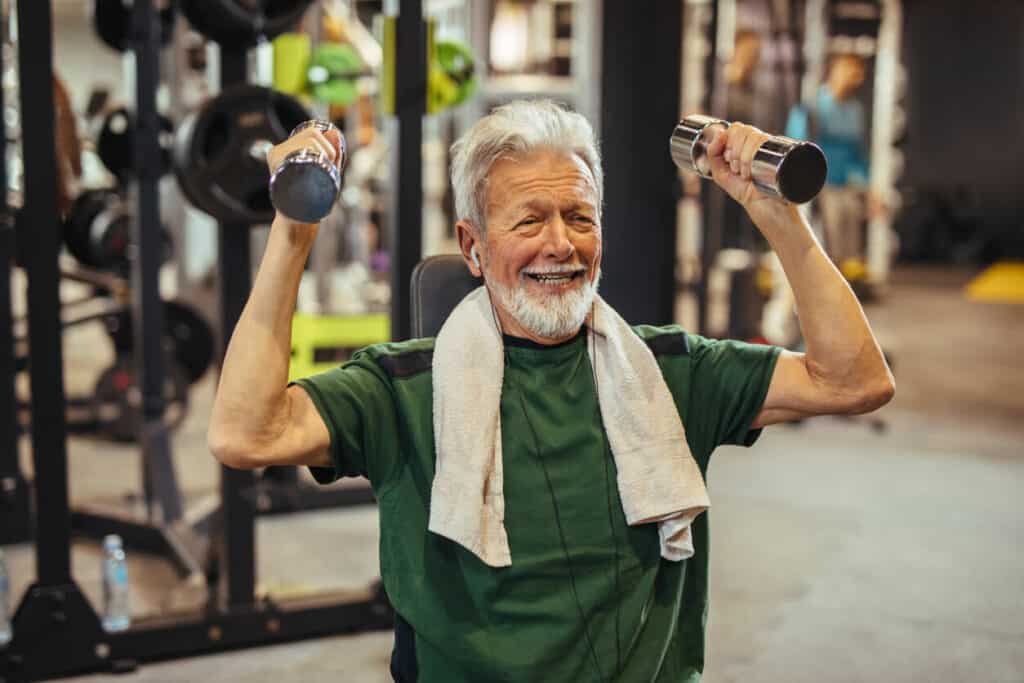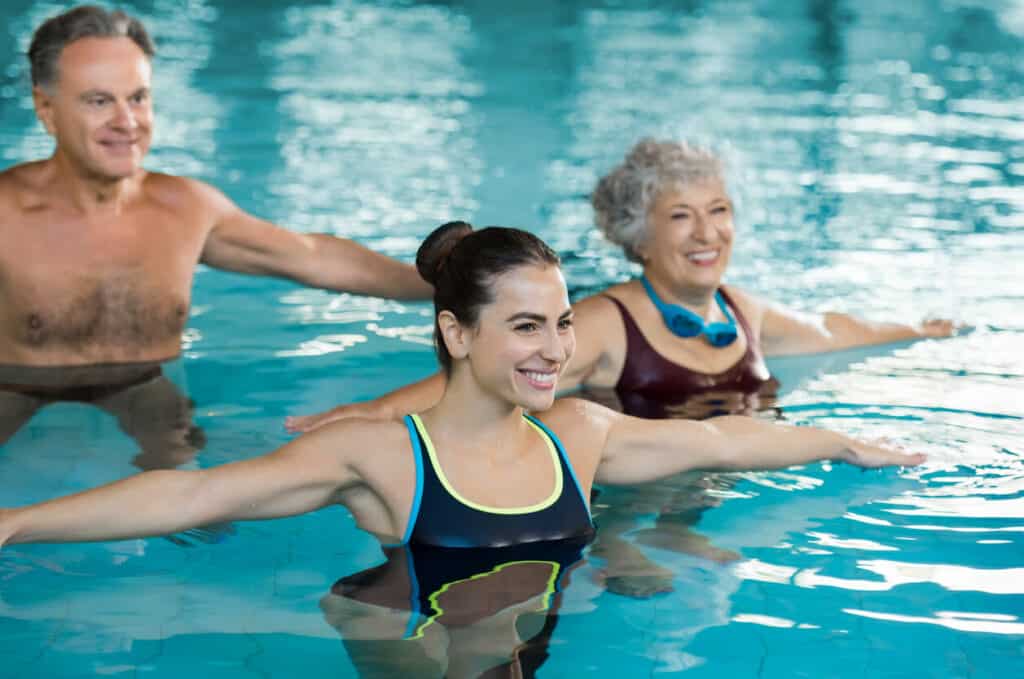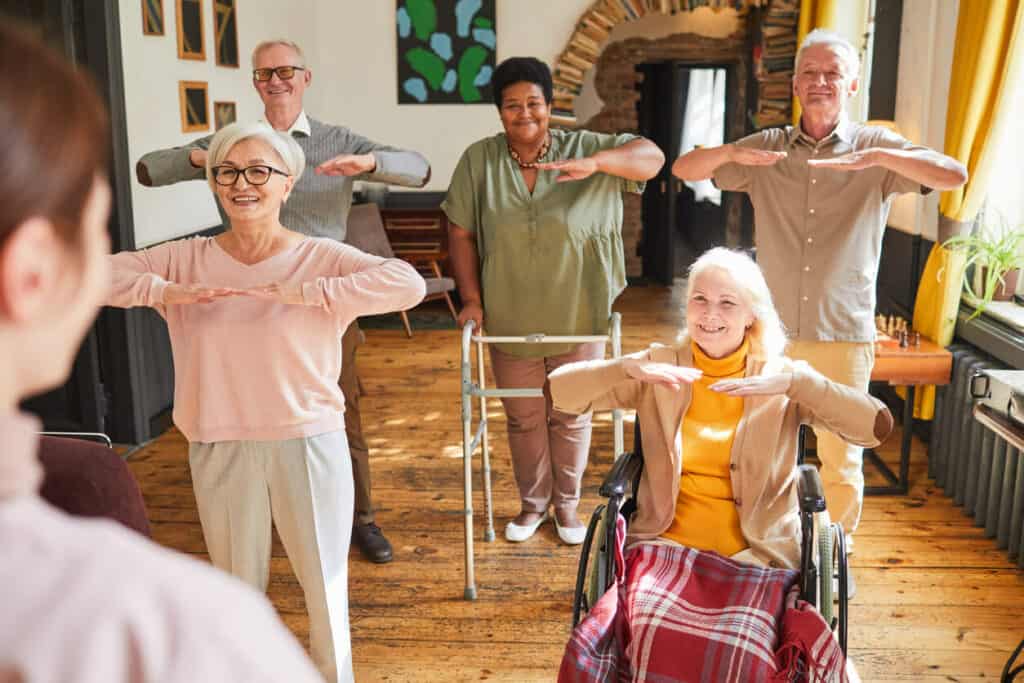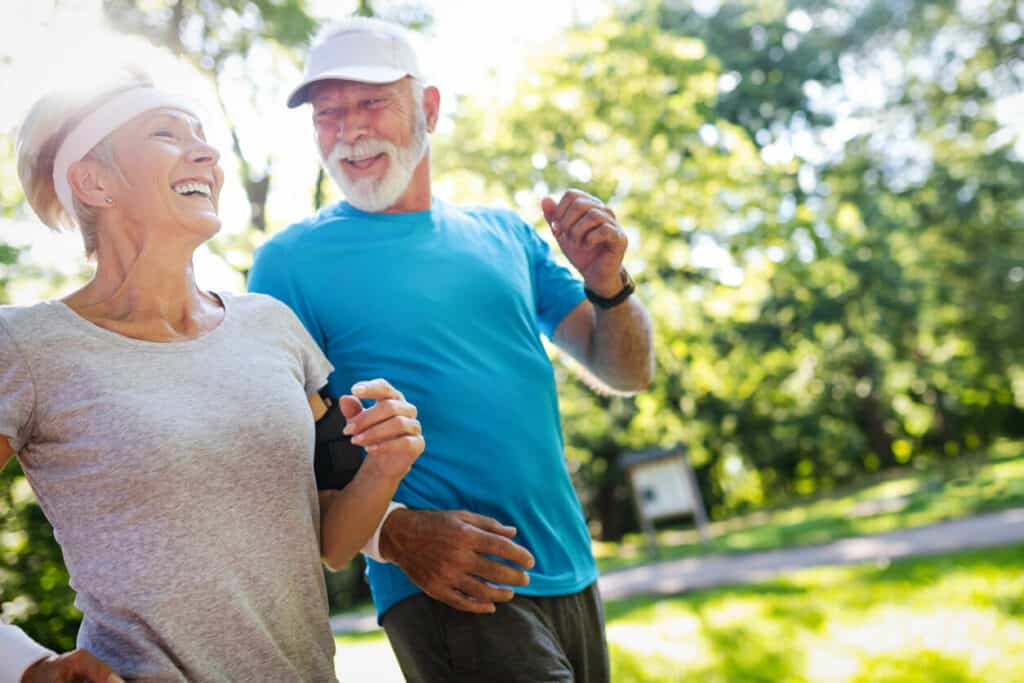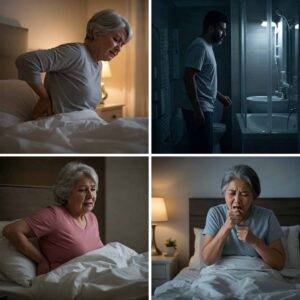A good and effective exercise routine can transform your body. If you hardly believe this, get on social media, and you’ll find a lot of videos of overweight younger people losing a significant amount of weight and achieving a healthier body within months.
Exercise has the same benefits for older people. Take, for example, Joan MacDonald, a 76-year-old fitness fanatic living her best health.
Before engaging in yoga and weight lifting, doctors told her she needed increased medication dosages for high blood pressure, acid reflux, and high cholesterol. However, after years of consistent senior exercise comprising cardio and strength training, she got a clean bill of health from her doctor. What sounds even better is that she’s also medication-free.
Hearing health success stories like Joan’s inspires us here at Amy’s Eden to encourage all seniors to take charge of their physical health and wellness by integrating exercise into their daily rituals.
The Importance of Exercise for Seniors
Regular senior exercise programs improve your aging loved one’s physical, mental, and psychological health. Here are some of its notable benefits.
1. Prevents diseases
The most significant benefit of exercise is it drives away diseases. It strengthens the lungs, heart, and other organs. It also prevents obesity, which is a contributor to liver diseases. To sum it up, exercise fortifies natural immunity and helps the different systems in the body, such as the cardiovascular system, to function more efficiently.
If your senior parent is like many older people watching too much TV, talk to them about signing up for a senior exercise program at a local gym.
2. Keeps pain away
The muscles get stiff when the body is inactive. It causes body pain when this stiffness inhibits mobility. A frequent senior exercise routine ensures that muscles are always engaged and are flexible to use for different ranges of motions.
3. Sustains mobility
Daily exercise that includes stretching can help you or your senior loved one stay in motion, essential to good mobility health. Good mobility, balance, and coordination from regular exercise can also reduce the risk of falls and home injuries.
4. Makes them strong and increases self-esteem
Lifting weights, resistance bands, and other strength senior exercise workouts can increase muscle strength, flexibility, and endurance. It makes your senior mom or dad feel good about themselves on the inside, and this radiates confidence on the outside.
5. Have a better quality of life
Physical exercise boosts overall seniors’ health, which is crucial to having a better quality of life. It decreases hospital admission because of illnesses and accidents and minimizes healthcare expenses.
Older adults who exercise are also more self-sufficient in running their households and have a more positive outlook on aging.
For many seniors, performing senior exercise routines alone can be challenging. If this sounds like your loved one, working with a senior caregiver is helpful. The caregiver can assist your senior family member in doing proper body posture, forms, and alignment during exercise.
The Mental Health Benefits of Exercise for Seniors
Physical exercises can improve mood and reduce depression, anxiety, and other mental health problems. Let’s dive into the various mental health benefits of exercise for older individuals.
Reduce feelings of isolation and loneliness
Exercising helps release happy hormones, like serotonin and endorphins, which boost your loved one’s mood. When their mood is good, they feel optimistic about getting in touch with people and improving their social life.
Boosts cognition
Exercise increases blood circulation to the brain. When there’s a sufficient supply of oxygen and nutrient-rich blood to the brain, it can efficiently clear away the toxic proteins and wastes, like amyloid beta, a risk factor for Alzheimer’s and dementia. With toxins gone, the brain functions optimally.
Studies have suggested that people who exercise have a greater volume of the prefrontal cortex and medial temporal cortex, the brain areas that control thinking and memory, compared to those who don’t.
By doing consistent senior exercise routines, your loved one will think more clearly and have a better memory.
Improves sleep quality
Quality sleep is pivotal in mental health. In fact, sleeping troubles are early signs of mental health problems such as
- Depression
- Sleep disorders
- Bipolar disorder, and
- Anxiety.
According to Harvard, 50% of those diagnosed with a generalized anxiety disorder (GAD) experience sleep problems, and between 69% to 99% of those with bipolar disorder experience insomnia or sleep deprivation during a manic episode.
Getting at least eight hours of high-quality sleep does wonders for cognition, allowing the entire body to rejuvenate. It also enhances concentration, attention, and memory.
Stress relief
Accumulated or chronic stress in the body converts into flare-ups of painful physical symptoms, like soreness of the muscles and joints and spasms — but this is not the end of it all. Chronic stress can elevate the risk of burnout, substance use, depression, and suicide ideation for some people who don’t know how to cope.
Doing 30 minutes of senior exercise programs at home, like yoga or Zumba, is one of the safest methods to relieve built-up stress. Not only does exercise distract your loved one from everyday worries, but the good chemicals released by the brain during exercise also increase stress tolerance.
Helps reclaim social life
Exercise gives your loved one excellent opportunities to socialize with gym-goers, people at their favorite parks where they go for a morning walk, and their in-home caregiver who assists them with their morning senior exercise routine. Exercise gives them a good reason to talk to others and build a connection with them.
Types of Exercise for Seniors: Finding What Works Best
There are various senior exercise ideas at home for aging people with unique needs. If your loved one wants to see progress in their exercise routine, they must choose physical activities that match their ability level and interest. It’s essential that they like the exercise they do so it doesn’t feel like a struggle for them.
Here are some senior exercise examples and the benefits of each.
Yoga
Yoga gets seniors double benefits because it’s not only good for the body but also for the mind. It promotes mindfulness and maintains a balanced metabolism.
Yoga comes in different forms, like aerial, chair, restorative, etc. If you’re unsure, or have questions about which type of yoga will benefit your senior the most, talk to your family’s doctor or a yoga instructor for proper recommendations. They can help map out the best yoga exercises your loved one will enjoy.
Pilates
Pilates is one of the senior exercise examples that’s low-impact and benefits most seniors. Many of the moves in Pilates are like yoga. The difference is that yoga emphasizes body balancing, while pilates is a better choice for older people wanting to strengthen their core muscles.
Constant muscle training improves body stability. It may also increase bone density and mitigates the risk of osteoporosis. Like yoga, it also has variations and forms. If your loved one wants to try this, ask a doctor or a Pilates instructor about which modifications are the best for an older person.
Walking
Walking exercises are the most underrated form of senior exercise at home. Most people don’t even think of it as a meaningful physical activity. However, its tremendous benefit for seniors’ health makes it one of the safest and simplest fitness activities as it requires no equipment and can be done anywhere.
According to Harvard, walking for 21 minutes daily or 2.5 hours per week can reduce heart disease risk by 30%. Another study found that every minute of brisk walking can minimize the risk of obesity in women by 5%.
If your parent loves walking exercise and wants to try various forms, many options are available, such as
- Nordic
- Brisk
- Chi
- Race, and more.
Strength training exercises
Strength training exercises may be worth doing for seniors wanting to prevent osteoporosis. They can also help mprove balance and lower body strength.
Since strength training requires dumbbells, barbells, or resistance bands, your loved one needs to work with a fitness coach who can guide and assist them in performing the exercise.
The coach can also help determine which type of strength training routine is safe and suitable for your loved one’s current level of strength and ability.
Aquarobics
Aquarobics or water aerobics are quite popular among seniors because it’s enjoyable, especially in groups. It’s a suitable physical activity for those with arthritis who love to swim.
Water aerobic classes are also a good social activity and, an excellent workout for the heart muscles.
The pressure from the water also offers resistance training, which is good for toning the muscles. Some types of aquarobics include:
- Swimming,
- Water walking,
- Water jogging, and
- Flutter kicking.
Biking or cycling
Some people may disagree about biking being a safe exercise for seniors. Yet, a physical therapist agreed that biking is an excellent exercise for healthy older people. It’s a low-impact aerobic and cardio exercise and an ideal outdoor weight-loss activity.
Biking or cycling indeed comes with risks, so here are some senior exercise tips to stay safe on the road.
- Choose the right bike for your loved one’s level of skill.
- Select the route wisely. Avoid trails that aren’t comfortable.
- Wear a helmet and elbow and knee pads.
- Go out when there’s no traffic on the route.
- Make stops to rest.
- Look two times to the left and right before crossing the road.
- Learn the hand signals for cyclists.
It’s best if your senior parent joins a local cycling club or community. Joining a club and riding in a group is safer. You also get to learn the proper etiquette of group cycling.
Hobbies
You or your loved one might have yet to think of hobbies as an exercise. Still, hobby-based physical activities, like dancing, hiking, gardening, playing golf, and martial arts, offer essential health benefits.
If your loved one’s hobby involves moving the body, doing it more often might be a good idea. For instance, if they love to hike and the doctor confirms they’re fit enough to do it two or three more times a week, they may skip the gym.
If you or your senior loved one is starting a senior exercise program at home, a senior caregiver can help you choose a set of exercises that match your abilities and interests. A caregiver can also guide your loved one on the proper forms and movements to avoid injury.
Staying Motivated: How to Encourage Seniors to Keep Up with Exercise
Committing to exercise for the long term requires a great deal of willpower, persistence, and motivation, which many seniors may lack.
Physical and physiological benefits, like weight loss and risk reduction for illnesses, may take two to three months to be noticeable. Hence, staying on the exercise program for months is critical to getting results.
Here are our suggestions to encourage seniors to stick with their exercise routine.
Make exercise enjoyable
Each person has a different preference for physical activity. Some seniors may find running satisfying, but others may find it boring. Find what’s interesting, fun, and sustainable.
Incorporate exercise in the morning
Based on a study, 7 AM is the best time to work out rather than the afternoon or evening. Morning exercise may support higher sleep quality and help stabilize the circadian rhythm.
Another study cited that exercising before breakfast and on an empty stomach could help burn fat by up to 20% more.
Keep track of small progress.
Celebrating small wins brings about feelings of success, pride, and accomplishment. These positive emotions can fuel your loved one to keep working toward their exercise goal, whether to achieve a healthy weight or strengthen their body.
Progress, no matter how menial it is, is a step forward to creating the healthiest version of oneself, so acknowledge and celebrate it.
Make exercise a social activity
An active social life is as integral as physical health for older people. One of the best ways to stay socially active is by talking to people at the gym center or a yoga studio. Your loved one can make exercise a duo or a group activity by encouraging other family members, coworkers, or friends to go for a morning run together.
Seniors can also join hobby clubs, like a dance club if they love dancing, and hit two birds with one stone by promoting their physical and social life.
Additionally, local parks or recreation centers may have a full calendar for group exercise classes or special events for seniors. Please feel free to call and find out if these are available in your local area, and encourage your loved one to participate.
Include rest as part of the regular exercise routine.
Successful senior exercise programs for healthy clients include rest because it’s vital for body recovery. Exercising for an entire week can strain the body, so let your loved one start two to three times a week. Then increase the exercise duration as they go along.
Taking days off from exercise ensures your loved one is physically and mentally prepared for the next training session.
Common Health Concerns and Exercise Modifications for Seniors
Seniors with existing health conditions can engage in physical activities as well. Modifying the exercise according to their specific health concern is the trick to make it work. Ask your care provider or healthcare team for health advice before your loved one engages in physical activity.
Here are some senior exercise ideas with modifications for seniors with a health condition.
1. Heart disease
If your senior relative has a heart disease, the doctor may recommend doing an aerobic activity, like swimming, biking, walking, and light jogging, which makes the heart and lungs work a little harder.
Seniors doing aerobics must move at a slower pace and take frequent breaks before they get too tired. Once they complete one set of exercises, the body needs to cool down. They can repeat this cycle until they complete the training session.
2. Alzheimer’s and dementia
Exercise is tailored to the senior’s skills and abilities if they have dementia or Alzheimer’s, depending on the level of care and supervision they need. Those with mild-to-moderate dementia may do gardening, tai chi, or swimming. Seniors with severe dementia may do stretching, walking, and seated exercises.
People with cognitive disorders must do directed exercise, either with a fitness trainer or a dementia caregiver. A memory caregiver can supervise exercise and closely monitor the changes in behavior and physical symptoms, such as when someone suddenly becomes anxious while exercising.
You can visit this page from the National Institute of Aging on more resources and info for staying physically active with Alzheimer’s.
3. Arthritis
The idea of exercise can be challenging for those with stiff joints. However, low-impact exercises like water aerobics and walking are drug-free treatments to ease arthritis pain and improve the joints.
Roughly 85% of people with rheumatoid arthritis (RA) experience discomfort during exercise, which is not an excuse to miss daily physical activity. People with RA who exercise regularly can reduce the risk of serious health conditions like;
- cardiovascular diseases,
- osteoporosis, and
- diabetes.
A good amount of exercise for those with RA is 30 minutes daily for five days with moderate-intensity senior exercise. Your loved one can also do three repetitions of 10-minute short workouts throughout the day to meet the recommended 30 minutes of fitness activity.
Let your loved one stick to low to zero-impact exercises, such as yoga, pilates, dancing, weight training, biking, and walking, to avoid aggravating their arthritis symptoms and worsening the joints.
4. Diabetes
During exercise, the body uses more glucose, which helps regulate the blood glucose levels (BGLs) to a healthy limit. As exercise can affect blood sugar levels, seniors should avoid excessively strenuous activity and heavy lifting as it makes the body produce more stress hormones, causing the liver to release glucose.
For people with diabetes, low- to moderate-impact exercises are the most suitable. It may include:
- Walking
- Stretching
- Stationary bicycling
- Swimming, and
- Moderate weight training
5. Seniors with disability
Exercise is like a wonder drug for people with physical disabilities because of its abundant benefits, like controlling weight, lowering the risk of premature death, and improving mental health.
As seniors with disabilities tend to get lonely, depressed, anxious, and experience sleeping disorders, exercise is a positive lifestyle addition to promoting a healthier state of mind.
Some of the senior exercise activities to try are cardio exercises such as walking and aqua jogging, and strength, flexibility, and balance training, such as yoga and tai chi.
If a loved one uses a wheelchair, get health advice from a doctor or a physical or geriatric occupational therapist before starting any exercise program. Also, communicate with your healthcare provider to determine what exercise routines are safe for your senior relative.
Making Exercise a Part of Everyday Life: Incorporating Movement into Daily Tasks
Exercise doesn’t have to be painful and uncomfortable. It can be fun and a form of socialization if done in a group.
When doing any senior exercise, ask your loved one to pay attention to the signals of pain, fatigue, and discomfort that their body sends. These signs will tell if they’re overstraining their body and overusing their muscles, which is counter-beneficial to health.
Although starting with low to moderate exercise is normally deemed safe, seniors with severe health conditions like diabetes and dementia should consult their healthcare providers first. If possible, they should get a doctor’s clearance to guarantee that exercising won’t put their health at a higher risk of a medical emergency.
Consistent exercise is pivotal in achieving a better quality of life. You can follow the tips outlined in this article to motivate your loved one to love exercise and make it a part of their daily routine and tasks.
Having an exercise companion is an excellent strategy for establishing an effective exercise routine. In this case, Amy’s Eden in-home senior caregivers can help incorporate movement into your loved one’s daily routine so they can live a healthier life. Contact us to learn more about our caregiving services.
usechatgpt init successusechatgpt init successusechatgpt init successusechatgpt init successusechatgpt init success

Memory Care vs Assisted Living: Which is Right for Your Parent in Reno?
Watching a parent age can feel like navigating a landscape of difficult questions and emotional decisions. You want what’s best for them—a life filled with



